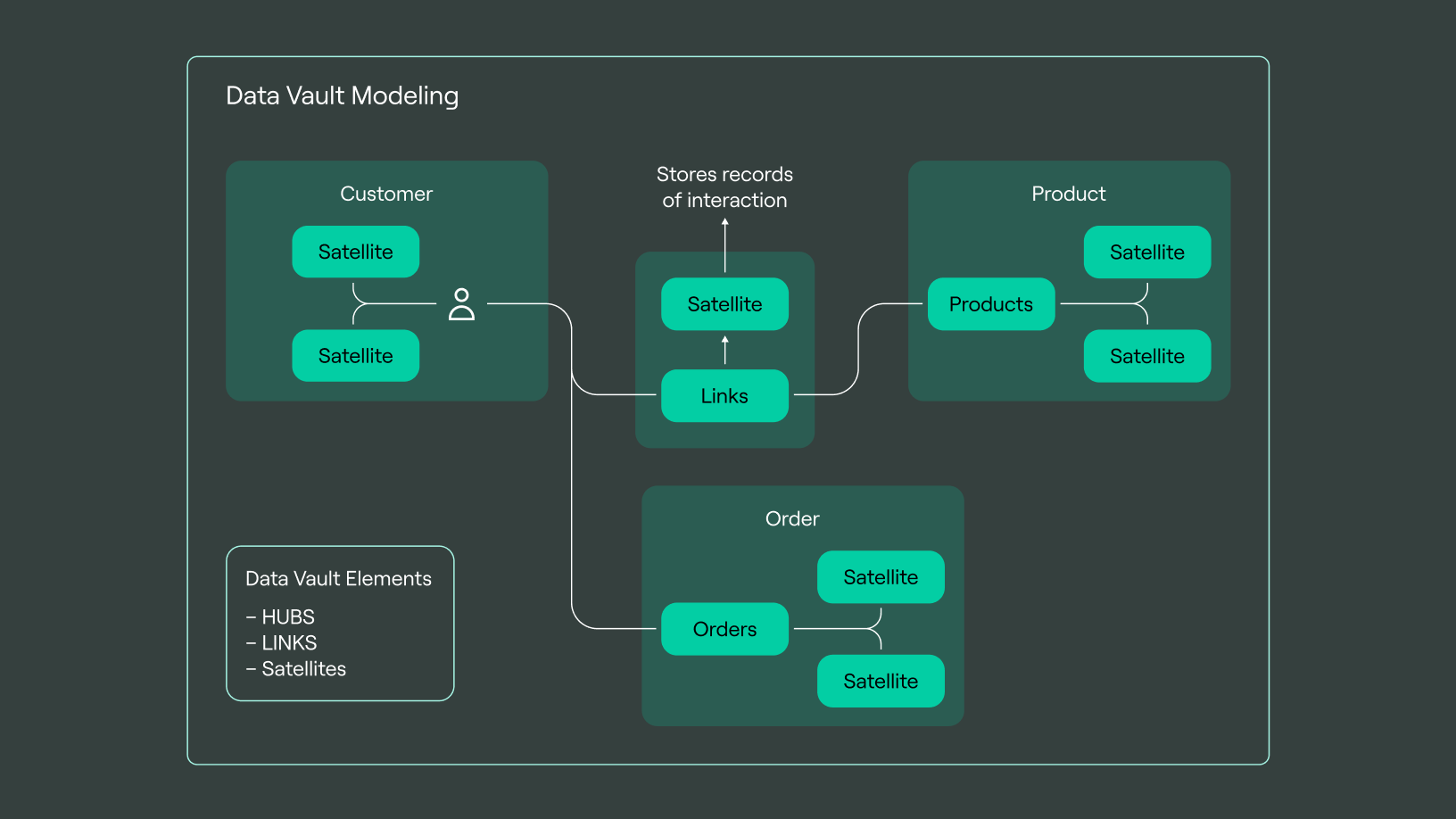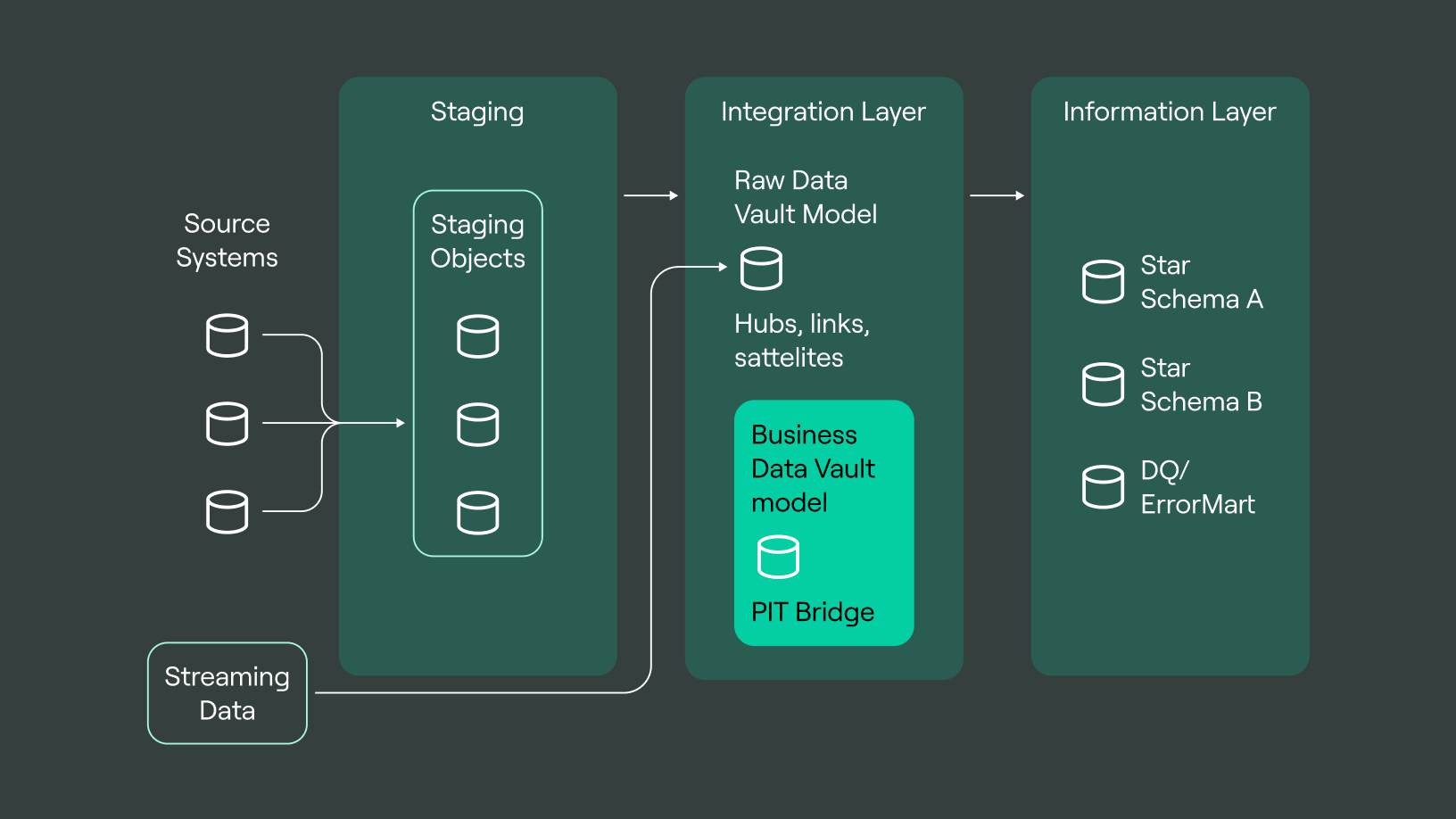
What is data vault?
In today’s competitive world, data is becoming an increasingly important entity.
Many businesses are gaining or losing success due to their data modeling strategies. The million‑dollar question however is how a company can effectively and efficiently represent data to achieve flexibility, scalability, and agility.
Data Vaults are often the answer to this question.
What are Data Vault applications though? What are the advantages of a Data Vault over other schemas? Why should we implement it in the cloud?
Definition Of A Data Vault
A Data Vault is a hybrid data modeling system that provides a comprehensive solution in terms of methodology and architecture to meet the business needs of any enterprise through the effective and efficient implementation of advanced data warehouse techniques.
Data Vaults not only overcome the shortcomings of 3NF but also provide a consistent, scalable, flexible, and adaptable design, suitable for addressing the emerging needs of modern‑day enterprises, which other mainstream data modeling approaches have failed to provide.
A Data Vault is based on three significant entities, namely:
- Hubs
- Links
- Satellite

What are the core elements of a data vault?
Data Vault modeling breaks data down into small elements that are the building blocks of its architecture, providing a standardized, easy‑to‑understand, easy‑to‑implement approach. Let’s discuss them in more detail:
HUBS: These core processes exist within an enterprise, such as customers, products, vehicles, orders, stores, etc.
A business key will be used to access the information about the HUB whenever a user requests it. The business key may contain a combination of business concept ID and sequence ID, as well as the load date and metadata.
Hubs do not provide any information about the entity; instead, they only contain the business key and a few Data Vault fields. It only has one row for each key.
LINKS: These provide the connection or relationship between the HUBs or Satellites. Instead of providing contextual information about the entities, it represents the relationship between two or more HUBS or Satellites. Links can easily connect two or more Hubs, giving the Data Vault a competitive advantage over other data warehousing approaches.
A new link will not affect Hubs or Satellites, making Data Vault modeling an agile and iterative process.
Satellite: These are the data vault entities that store HUB‑related information and its relationships. Data can be separated using satellites based on their classification or sensitivity. Additionally, it separates data elements to handle special security considerations. Two or more satellites can only have a direct connection with one another. A Hub or a link can use one or more satellites.
The layered architecture of a data warehouse using data vault schema
A Data Vault based data warehouse consists of four layers, as shown in the image:

Staging Layer: This layer stores the most recent changes from source systems and uses them to perform transformations such as character set conversion, data type changes, and the addition of meta‑data columns to support future processing.
RAW Data Vault: It is part of the integration layer and is exclusively used to store information from different sources.
Business Data Vault: This vault is a non‑mandatory entity in the integration layer. This vault data performs business‑centric calculations and de‑normalization to improve speed and accessibility. This data vault contains the following objects:
PIT (Point in Time) table: This table contains data from multiple satellites for a single hub, each with a different time stamp. It is used to make business data vaults more accessible and faster.
Bridge Tables: This table collects data from multiple links and denormalized it. It could be a table or a materialized view like the Pit table.
KPI Tables: It is used to store the key performance indicators (KPIs) of previously computed business rules.
Type 2 Tables: It is used for calculating and storing the type 2 time period; additional processing occurs within the business data vault.
Information Layer: This is a place where consumers access information. It contains user interfaces or dashboards.
Problems with other data modelling approaches
Other data modeling approaches, such as Enterprise Data Warehousing and Dimensional design approach, generates a number of problems, such as:
- Time and Effort: The traditional data modeling approach requires more time and effort because the data must be loaded into a central repository before reporting.
- Requirement of skilled workforce: Gathering and integrating data from various sources for enterprise‑level data modeling is a complicated procedure that may need the use of a skilled workforce capable of meeting complex business requirements.
- Non‑Adaptive approach: In the traditional enterprise data warehousing approach, introducing additional sources for modeling the existing data relationship necessitates significant rework, rendering this approach non‑adaptive and complex.
- Complicated Code: Over time, the ETL Code (Extract, Transform, and Load) becomes more complicated, making it nearly impossible to structure, change, clean, confirm, and avoid duplicate data using a single code.
- Lack of new data relationships: Because of the landing area’s transient nature, analysts cannot define new data relationships with raw data, diminishing the significance of data sciences.
- History Management: Back‑populating additional data feed is difficult due to a lack of raw data history.
- Challenging Data Trails: Tracing the data item from the source system becomes impossible as the source code becomes more complex and lengthier due to the implementation of technical and business logic. It not only has an impact on data management, but it also slows down data traversal.
Benefits of data vault schema
As we’ve seen, there are numerous issues with traditional data modeling approaches such as enterprise data warehousing and the Dimensional Design Approach. Data Vault is a comprehensive solution that addresses the shortcomings of conventional vaults. The following are the advantages of this vault data:
- Adaptability: Unlike other traditional data modeling approaches, Data Vault allows users to incrementally add data sources, requiring no major rework.
- Flexible solution: The ability to incrementally add data sources to Raw and Business Data Vaults without rework makes it a more flexible solution than the third normal form. The adaptability of Data Vault allows it to accommodate any change in business rules.
- Less Complexity: Because the data vault stores technical and business data in separate vaults, it is less complex. This capability isolates both steps and prevents business rules from being applied to technical data.
- Raw Data Availability: Because of the transient nature of the landing area in traditional approaches, analysts cannot define the relationship with the raw data; however, the data vault allows for the storage of raw data, allowing it to back‑populate the presentation area with historical attributes.
- Accommodation of Change: As the data vault stores technical and business data in separate containers, it is less complex and can easily accommodate changes generated from different sources over time.
- Data Lineage and Audit: A data vault ensures that modifications and results are always recovered with each incremental update. It stores metadata that gives a robust data trail capacity to identify the source for this purpose. In this manner, an automated audit of the data is also performed.
- Speed: Data vault eliminates data loading dependencies previously included in standard data modeling methodologies such as dimensional design. With the Data Vault 2.0's parallel load capabilities, users can now access real‑time data.
- Ease of access & automate: The previous approaches require highly skilled personnel, which takes time. Still, with the data vault, this is different as it has several tools to automate the solution, such as dbtvault, wherescape, vaultspeed, data vault builder, and so on.
Advantage of data vault in the cloud
Due to increased competition, traditional data modeling approaches will no longer benefit enterprises. As a result, cloud‑based data vaults are more advantageous because they are easier to set up and provide greater speed, scalability, adaptability, and agility. Let us go over them in greater depth.
- Accessibility: A global footprint is becoming an essential requirement for many small to large enterprises, and remote work or work from home is a new culture today, so data access is critical. As a result, a cloud‑based data vault can meet all of today’s emerging needs because it is simple to access via multiple concurrent connections while maintaining data integrity.
- Scalability: Because incremental data addition is the most powerful feature of data vaults, they require a technology that can support their scalability requirements. Cloud architecture is a solution that can accommodate modern enterprises' fluctuating needs while charging them only for the features that they use.
- Speed: Although modern data vaults provide high‑speed data modeling, another requirement of modern enterprises, what if they run on slower and more limited platforms, such as on‑premises servers? As a result, it is critical to use a cloud‑based solution that gives them access to multiple servers while also sharing the processing load. As a result, cloud‑based data vaults can serve their customers more quickly and efficiently.
- Agility: Cloud architecture can also enable multiple users, analysts, and consumers to access their data with great speed, performance, and agility because data vaults, which already segregate technical and business data in different containers, have the support of cloud‑based multiple parallel servers, which reduces its footprint and increases productivity.
- Reduced IT Cost: Maintaining a data vault in a cloud environment reduces the operational and capital costs of an IT system (Hardware, Software), energy consumption, system upgrades, human resource costs, and so on.
- Business Continuity: Data safety and security are significant concerns for any enterprise to keep the show running. This should no longer be a concern in cloud‑based data vaults because the data is available and backed up in multiple locations, so your business can continue to operate whether there is a natural disaster, riots, fire, or power outage.
In today’s competitive world, keeping up with the latest technologies is critical, and Data Vault is one of them. As we have seen that Data Vault has many features under its sleeves, and implementing it in the cloud is just icing on the cake.
As a result, we advise any small to large enterprise planning to change their data modeling methodology to adopt this cutting‑edge technology. If you want to learn more, keep visiting the Double Cloud website.
Start your trial today


